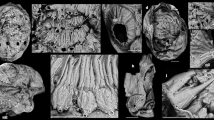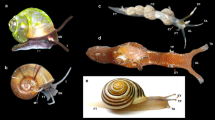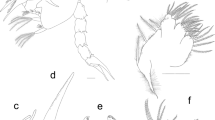Abstract
THE mouthparts of the Norway lobster Nephrops are colonized by an acoelomate metazoan, Symbion pandora gen. et sp. nov. Sessile stages continually produce inner buds replacing feeding structures. They also produce one of three motile stages: (1) larvae containing new feeding stages, (2) dwarf males, which settle on feeding stages, or (3) females, which settle onto lobster mouthparts, and eventually degenerate, giving rise to dispersive larvae. All motile stages are short-lived, and do not feed. The structure and function of the cilia suggest a phylogenetic position in Protostomia, while some aspects of inner budding and brooding of larvae are similar to those of Entoprocta and Ectoprocta. The dispersive larva possesses a mesodermal supporting chordoid structure, otherwise absent in protostomian larvae. We believe that all the above features of this previously undescribed species warrant the recognition of a new phylum with affinities to Ectoprocta and Entoprocta.
This is a preview of subscription content, access via your institution
Access options
Subscribe to this journal
Receive 51 print issues and online access
$199.00 per year
only $3.90 per issue
Buy this article
- Purchase on Springer Link
- Instant access to full article PDF
Prices may be subject to local taxes which are calculated during checkout
Similar content being viewed by others
References
Nielsen, C. Acta zool. 68, 205–262 (1987).
Strathmann, R. R., Jahn, T. L. & Fonseca, J. R. C. Biol. Bull. 142, 505–519 (1972).
Nielsen, C. Animal Evolution (Oxford Univ. Press, Oxford, 1995).
Koehler, J. K. J. Ultrastruct. Res. 12, 113–134 (1965).
Koehler, J. K. & Birky, C. W. Z. Zellforsch. 70, 303–321 (1966).
Melone, G. & Ferraguti, M. Acta zool. 75, 81–88 (1994).
Wright, K. A. in Microscopic Anatomy of Invertebrates Vol. 4 (eds Harrison, F. W. & Ruppert, E. E.) 111–195 (Wiley-Liss, New York, 1991).
Ruppert, E. E. in Microscopic Anatomy of Invertebrates Vol. 4 (eds Harrison, F. W. & Ruppert, E. E.) 41–109 (Wiley-Liss, New York, 1991).
Rieger, R. M., Ruppert, E., Rieger, G. E. & Schoepfer-Sterrer, C. Zool. Scripta 3, 219–237 (1974).
Manylov, O. G. Acta zool. 76, 1–6 (1995).
Nielsen, C. Ophelia 9, 209–341 (1971).
Marcus, E. Mosdyr (Bryozóa eller Polyzoa) Danm. Fauna Vol. 46, 1–401 (1940).
Brien, P. Annls Soc. r. zool. Belg. 84, 301–444 (1953).
Author information
Authors and Affiliations
Rights and permissions
About this article
Cite this article
Funch, P., Møbjerg Kristensen, R. Cycliophora is a new phylum with affinities to Entoprocta and Ectoprocta. Nature 378, 711–714 (1995). https://doi.org/10.1038/378711a0
Received:
Accepted:
Issue Date:
DOI: https://doi.org/10.1038/378711a0
This article is cited by
-
Chemical communication and its role in sexual selection across Animalia
Communications Biology (2023)
-
The neuroanatomy of Barentsia discreta (Entoprocta, Coloniales) reveals significant differences between bryozoan and entoproct nervous systems
Frontiers in Zoology (2019)
-
Transcriptome profiling of Symbion pandora (phylum Cycliophora): insights from a differential gene expression analysis
Organisms Diversity & Evolution (2017)
-
Genetic variation and geographic differentiation in the marine triclad Bdelloura candida (Platyhelminthes, Tricladida, Maricola), ectocommensal on the American horseshoe crab Limulus polyphemus
Marine Biology (2017)
-
On 20 years of Lophotrochozoa
Organisms Diversity & Evolution (2016)
Comments
By submitting a comment you agree to abide by our Terms and Community Guidelines. If you find something abusive or that does not comply with our terms or guidelines please flag it as inappropriate.



